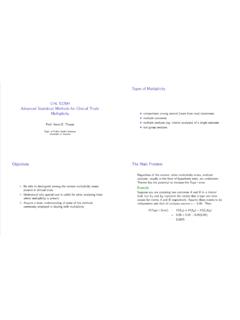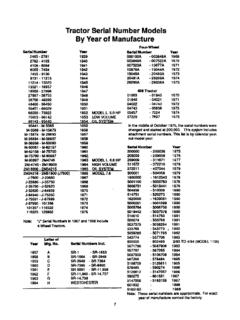Transcription of Models for Survival Analysis with Covariates
1 Models for Survival Analysis with CovariatesJanet RaboudCHL 5225: Advanced Statistical Methods for Clinical TrialsTopics Survival terminology Proportional hazards Models Partial likelihood Checking assumptions Residuals Time dependent Covariates Multiple failuresMeasuring Survival Time Time is measured from Start of the risk period or study period Clinical trials Time of randomization Time of intervention Cohort Studies Enrollment into cohort? Age? Time the exposure started? Calendar year?Censoring Censoring is the defining feature of Survival Analysis , making it distinct from other kinds of Analysis .
2 Some failures are not observed Right Censoring Most common kind Individuals are known to not to have experienced the event of interest before a certain time tbut it is not known if they have the event later or at what time the event occurs Reasons for censoring Loss to follow-up End of studyCensoring (continued) Left Censoring some failures/events occurred before observation started Interval censoring time is only known to fail between two dates Diagnosis of diabetes Infection with HIV (between last negative and first positive test) Suppression of HIV virus Assumption: Censoring occurs at random and is unrelated to failure processNotation Outcome of interest is failure time T If all failures were observed, we could model f(T)directly C= censoring time X= min(T,C) = observed end time =I{T < C} indicates that Xis a failure rather than a censored observation.
3 The kdistinct failure times from Nindividuals can be labeled as t(1), t(2), .. , t(k)ooFollow-up TimePatient 1 Patient 2 Patient 3 Patient 4 Patient 5 Patient 6 FailureCensored obsData for Survival Analysis Time Censoring indicator Covariate(s)IDTimeFailurex11212527030321 131415027512128618022728132 Left Truncation Left truncation occurs when an individual comes into observation some time after the natural starting point of the phenomenon. Eg. Measuring time from HIV infection to AIDS some individuals are not followed from the time of infection but come into observation some time later.
4 Want to make sure that these observations are excluded from the risk sets of failures which occur before they come under TimePatient 1 Patient 2 Patient 3 Patient 4 Patient 5 Patient 6 FailureCensored obsPatient 7 Left truncated(Ann Surg 2007;246: 734 740)Long-term Survival and Metastatic Pattern of Pancreaticand Periampullary Cancer After Adjuvant Chemoradiationor ObservationNumber RandomizedNumber of DeathsODS html;ODS graphics on; PROC LIFETEST data=BMT plots= Survival (atrisk=0 to 2500 by 500) maxtime=2500; TIME T * Status(0); STRATA Group / test=logrank; RUN; ODS graphics off;ODS html close;Median Survival Time The median Survival time can be estimated as the time at which the Survival curve reaches 50%, ie.
5 Where F(t)= .50 Can t estimate median Survival time if F(t)never reaches .50. The median Survival time is *not* the median of the Survival times of individuals who failed. Survival Functions Survival Function Probability density function Hazard function tdssttTttf0])exp[)Pr(lim)( )()()tFtft tdsstTtF0])exp[)Pr()( Full Likelihood Full likelihood for Survival Analysis Ti~f(t; )survivor function F(t; ) Ci~ g(t; )censoring functionG(t; ) Assuming censoring is independent of failure If G contains no information about parameters 11)};();({;(;({),L(iiiniitgtFtGtf][][][) exp)][)exp[)exp[));(.]]}
6 (),L(01011011dsstdssdssttFtftnitnitinii Proportional Hazards ModelsCox 1972, JRSS(B) Hazard function where 0(t) is an arbitrary and unspecified baseline hazard function that does not depend on Xis a vector of explanatory variables is a vector of regression coefficients associated with XXett )()0 TimeHazard Function 0(t)e Example of Baseline Hazard FunctionRatio of Hazard Functions )(z0101e)|)|zztzt kkkztzt e)|)1| is constant over time. is the HR associated with a 1 unit increase in For all t > 0. Since the baseline hazard is completely unspecified, we can t use the ordinary likelihood to estimate Cox proposed the idea of a partial likelihood to remove the nuisance parameter 0(t) from the estimating of the Partial LikelihoodiiRjjiRjjiiiRjjiiiiiiiiitRxxxt hxthxthxthttttittiiiiat risk at sindividualofset theis whereexpexpexp)(exp)()|()|() tosurvival|at event onePr() tosurvival|at timeevent hasIndividualPr()
7 At event one|at timeevent hasIndividualPr(00 We consider the probability that individual i, with covariate vector xi,is the one to experience the event at time ti, given that there is an event at time ti. iitRjjixxPL expexpThe product of all of these conditional probabilities is called the partial discard information about the actual times at which events TimePatient 1 Patient 2 Patient 3 Patient 4 Patient 5 Patient 6 FailureCensored obsPatient 7 Left truncatedTies in Event Times Death times are assumed to be unique when constructing the partial likelihood Ties can occur when a truly continuous time variable is not measured accurately enough When deaths and censoring times coincide.)
8 The censoring is assumed to occur immediately after all the deaths When death times coincide, the true arrangement of the ranks is unknown many possible permutations Fortunately, permutations within different death times can be treated independentlyPartial Likelihood when there are Ties in Event Times(Kalbfleisch and Prentice) Assume there are dievents at time ti Let Qibe the set of all subsets of size di, which can be selected from Riindividuals. iqqjjTqkkqqjjqkkqqjjiQkkiiiiiiQjjiiQjjii Qjjixxxxxthxthtdtq expexpexact PLThen,expexpexp)(exp)()at timeevents|at timeevent havesubset Pr(00 Can be very computationally for Ties Breslow: Efron.
9 I]exp[expPLiiiRjdjqkkTxx i11][expexpexpPLiiqmiiRjmTdljdlqkkTxxx Breslow s method is the default in SAS and is a good approximation when ties are not s method is a closer approximation of the exact of Coefficients The Newton-Raphson method is used to find an estimate of is maximized to find a solution to the likelihood equations 0log L jjjjll ()(1221][ with as an initial solution, estimates of the coefficients are found through an iterative Testing the Global Null Hypothesis Likelihood Ratio Test Wald s Test Score Test )]0()([2llLR 2212)0(where)0()0()0()0(][][ lllIIS covariateonefor (/ (['2 seVW Comparison of Test Statistics Each statistic has a chi square distribution with pdegrees of freedom, where pis the number of Covariates .)))]
10 All three tests are equivalent asymptotically. The likelihood ratio test is considered the most reliable, the Wald test the least reliable. The efficient score statistic is based on one iteration of the Newton-Raphson of Comparing Survival with PH Models in a Clinical Trial Randomized clinical trial (ACTG 320) of a new treatment for HIV disease compared to placebo 577 patients on placebo 574 patients on indinavir Outcome = new AIDS defining illness or death Randomization was stratified by CD4 countSAS code for PH modelsPROC PHREG data = data; model time * censor (0) = covariate; BY covariate; STRATA subgroup; RUN;SAS code for ACTG 320 PROC PHREG data = actg320.








